
Andy Lloyd's Dark Star Blog

Blog 45 (December 2016)
Life in the Clouds
I've spent many years extolling the virtues of life on a cold brown dwarf moon. Similar to the Galilean moons of Jupiter, a moon orbiting a sub-brown dwarf would be warmed internally by the tidal forces generated by its proximity to such a powerful gravitational force. Additionally, the sub-brown dwarf itself might provide some local heating, or at least an abundance of charged-particle strewn local magnetic fields to energise the sub-stellar environment. So, a habitable environment on a moon seems a likely scenario. If a cold, dark sub-brown dwarf were to be found orbiting the Sun at a great distance, then it neatly provides the grounding for extraterrestrial life on our doorstep (1). This seems to me to be the simplest scenario for life in a sub-brown dwarf system. There are complexities - tidally-locked moons (2), lack of light, and so on. But the basics are there.

Image credit: Mark Garlick/Science Source
Another exotic possibility is that the sub-brown dwarf itself might harbour life. The complex cloud systems in these failed stars can contain layers which are at room temperature, and abundant in water and other chemical goodies which could form the building blocks of life. A team of astronomers from Edinburgh University have been considering this very point, wondering whether very simple life might be able to get going in the clouds of a cold brown dwarf (3). This life might arise in two ways - either somehow evolving from scratch in the cloud environment, or originally being seeded into it by an impacting asteroid or comet. Either way, conditions for life might be good, except for the lack of a solid surface to dwell on:
"Floating out by themselves in the Milky Way galaxy are perhaps a billion cold brown dwarfs, objects many times as massive as Jupiter but not big enough to ignite as a star. According to a new study, layers of their upper atmospheres sit at temperatures and pressures resembling those on Earth, and could host microbes that surf on thermal updrafts.
..Observations of cold brown dwarf atmospheres reveal most of the ingredients Earth life depends on: carbon, hydrogen, nitrogen, and oxygen, though perhaps not phosphorous." (4)These ideas build upon work done by the late, great Carl Sagan (with his Cornell colleague E. E. Salpeter) on the potential for life in the clouds of the gas giant Jupiter, first considered back in the 1970s (5). They envisioned giant 'floaters' filled with hydrogen bobbing through the Jovian atmosphere, tiny 'sinkers' and self-propelled 'hunters' which had evolved from the lazy floaters (6). All very speculative, but presented in Dr Sagan's inimitably compelling fashion.
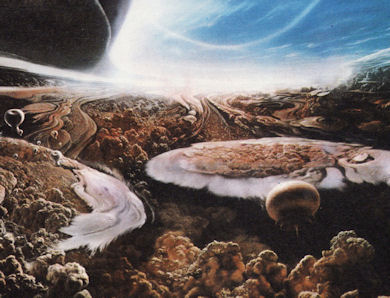
Image credit: Adolf Schaller (6)
By the way, anyone who thinks Sagan's general skepticism outweighed his belief in the prevalence of life throughout the cosmos should read Donald Zygutis's expose of Sagan's long-held belief in ancient visits by aliens to Earth (7). Sagan thought that life, including technologically-savvy life, must be out there in abundance. Over the lifespan of the galaxy, many interstellar-faring civilisations must have emerged, Sagan argued, based upon the statistical probabilities emerging from the Drake Equation (the odds seem way better these days (8)). Based upon a straightforward logical extrapolation, Sagan advocated that NASA, and other interested organisations, conduct an in-depth study of ancient myth to trace early contact with alien visitors. He even proposed that these might have included the Mesopotamian mythological creatures, the Apkallu:
“There are other legends which more nearly satisfy the foregoing contact criteria, and which deserve serious study in the present context. As one example, we may mention the Babylonian account of the origin of Sumerian civilisation by the Apkallu, representatives of an advanced, nonhuman and possibly extraterrestrial society”. (9)
As another aside, Sagan's SETI colleague Jill Tartar was the astronomer who first coined the term 'brown dwarf' back in 1975 (10). The colour nomenclature chosen for these objects was an educated guess at the time. Brown dwarfs are red, cooling in tone to magentas and purples as they move into the smaller, older and colder categories of sub-stellar objects.
Now, Jupiter's cloud systems are quite a bit colder than those of its more massive sub-brown dwarf cousins. So, if Sagan thought life could possibly exist in the frigid gaseous environments of our solar system's most massive planet, then the potential for life in the atmosphere of a cold brown dwarf would have got a big thumbs-up from him, I think. However, brown dwarf expert Mark Marley expressed a sceptical note about this Scottish research on Twitter:
"This is a cute idea but I really don't think brown dwarfs are habitable. Way too much vertical mixing." (11)
Dr Marley may be right, of course. This is all very speculative. Certainly, the Scottish team have downgraded expectations considerably from the ideas 'floated about' in the halcyon days of 'Cosmos'. From Sagan's original grand vision of enormous floating organic bags of gas back then, to mere microbial forms these days. This reflects a more conservative view of what we might expect to find 'out there' prevalent in science now. Less little green men (or organic helium balloons in this case), more extremeophiles eking out living in the nooks and crannies of barren alien worlds. It's sad, really.
For me, though, this is all rather academic. Because the real prize is what's going on in the planetary systems of these cold brown dwarfs. In my opinion, quite a bit!
Written by Andy Lloyd, 7th December 2016
References:
1) Andy Lloyd "Dark Star: The Planet X Evidence" Timeless Voyager Press, 2005
2) Andy Lloyd "More Support for Dwarf System Habitability" 17 July 2016
andylloyd.org/darkstarblog40.htm
3) Jack Yates et al. "Atmospheric Habitable Zones in Y Dwarf Atmospheres", The Astrophysical Journal, 836(2): 184 17 February 2017
4) Joshua Sokol "Alien life could thrive in the clouds of failed stars" 2 December 2016
5) C. Sagan & E. Salpeter "Particles, Environments and Hypothetical Ecologies in the Jovian Atmosphere "Astrophysical Journal Supplement, 32, p737, 1976
6) Carl Sagan "Cosmos" pp40-4, MacDonald & Co. Ltd 1980
7) Donald Zygutis "The Sagan Conspiracy: NASA’s Untold Plot to Suppress The People’s Scientist’s Theory of Ancient Aliens" New Page Books, 2017
8) Leonor Sierra, University of Rochester “Are we alone in the universe? Revisiting the Drake equation"” 19th May 2016
9) Carl Sagan “Direct Contact Among Galactic Civilizations by Relativistic Interstellar Spaceflight” Planetary and Space Science, 15th November 1962, p496, Pergamon Press Ltd
10) Jill Tartar "Brown Is Not a Color: Introduction of the Term ‘Brown Dwarf’" 4th November 2013, in "50 Years of Brown Dwarfs" Volume 401 of the series Astrophysics and Space Science Library pp 19-24
11) Mark Marley @astromarkmarley 3rd December 2016
Down a Dusty Lane
Picking up on the mystery of how a massive Planet X could form beyond the outer confines of the Sun's magnetic environment, as per my previous posts on the accretion of dust beyond the heliopause (1,2) and an exploratory scientific paper I published earlier in the year (3). I'm searching for evidence, or at least some educated guesswork, about whether interstellar medium beyond the heliosphere of stars might be sufficient over time to build up substantial, gaseous planets loosely bound to their parent star systems. Such planets might, I suggest, accumulate dust clouds and rings around them, undisrupted by the action of the solar wind trapped within the inner magnetic sphere of the solar system.
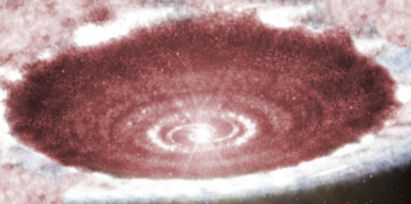
Could disks of matter be accumulating around massive objects in interstellar space? (3)
Even though this kind of accumulation could be gradually taking place over billions of years, creating a meaningful adjustment to the mass of a substantial planet over these kinds of time periods, it doesn't seem likely that this kind of effect could take place if our current interstellar environment is anything to go by (although the unexpected presence of interstellar 'fluff' beyond the heliopause, described by NASA (4), and the intrusion of large grain particles into the outer solar system (5) do offer some evidence of what could be 'out there').
Last month, I looked at evidence of massive stars being aided in their development by the dumping of immense quantities of neighbouring nebula material onto them (6). I wondered whether a similar mechanism might also be happening in interstellar space at the planetary level, based upon globular frameworks of nebula materials (like gigantic molecular clouds, and the like).
Another promising dusty environment could be the dust lanes bordering the spiral arms of the Milky Way galaxy, which the Sun moves through periodically. Catastrophists looking at the destruction wreaked upon the Earth at the time of the demise of the dinosaurs 66 Myr ago are reconsidering an old hypothesis about the action of massive dust clouds upon the Sun (7). There has been speculation in the past that the periodic movement of the Sun through the dusty borderlands around the galaxy's spiral arms might trigger ice epochs:
"...The passage of the solar system through a dust lane bordering a spiral arm of the Galaxy may cause a temporary variation of the sun's radiation and thereby lead to an ice epoch on earth. Calculations show that the passage of the solar system through very dense clouds could produce conditions leading to a brightening of the sun, an increase in precipitation on earth, and consequent onset of an ice age. It can be estimated that since its origin, the sun has passed through a spiral arm some 50 times in all, and rough estimates of time and duration of the passages agree qualitatively with the general picture of the ice age periods." (8)
The (disputed) idea that the Sun's movement through spiral arms might be coincident with the onset of ice epochs has been explored by a number of scientific researchers (9, 10), and is known as the galaxy-ice age hypothesis. Various mechanisms have been offered to explain the cooling of the Earth, from cosmic radiation upon the Earth's atmosphere ionising gas into cloud-forming plasma (11), to the soaking up of the Earth's atmospheric oxygen by the interstellar clouds, bringing down its ozone layer dramatically (12).
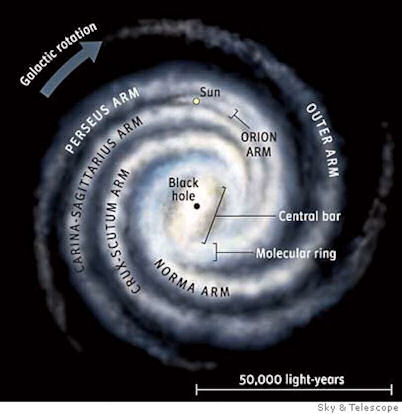
Another idea along similar lines was that the Earth's immediate space environment could be altered by the intrusion of dense interstellar matter into the solar system, pushing back the heliopause to a point actually within the Earth's orbit, thus rendering Earth and most of the other planets into a particularly cloudy interstellar space for a while (13).
So, while this is all very interesting, what I'm focussed upon here is the nature of these passages through dense fields of interstellar dust. Recent work on the iridium layer associated with the extinction event 66 mya that killed off the dinosaurs has indicated that the Earth was exposed to this cosmic material over a period perhaps as long as 8 Myr. The implication of this may be that the iridium may have been deposited during prolonged exposure to a gigantic molecular cloud (14). The encounter with this vast dark cloud would have led over time to climate change and mass extinctions.
The Ice Epochs are long-lived affairs, implying that the Sun's immersion in these dusty environments is prolonged (the very scale of the spiral arms themselves implies similar). Thus ample opportunity exists for the accretion of spiral arm interstellar dust around massive solar system planets beyond the heliosphere. Bear in mind that the dust clouds themselves are massive enough to push the heliopause back, potentially exposing the outer solar system gas and ice giant planets to this material, too. Once the clouds have passed, as the Sun moves on through, the heliopause is restored to its rightful place, and the action of the solar wind can once again clear out the Sun's inner sphere of influence. The dust and materials around the outer planets (Neptune, Uranus, Saturn, even perhaps Jupiter) previously gathered from the dust clouds during their incursion is thus largely removed.
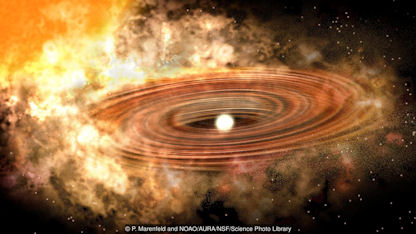
Image Credit: P. Marenfeld and NOAO/AURA/NSF/Science Photo Library
But this same mechanism does not apply beyond the current heliopause. A massive Planet X could accumulate a great deal of dusty material around it, forming a nebula environment. There is no solar wind at that distance to clear it all up after the Sun has moved to clearer realms. A massive Planet X body could then slowly accrete the material into complex rotating rings, moons, asteroids, whatever.
The elephant in the room here is that we are currently at the back end of a 4 Myr Ice Epoch. If there is a correlation between these Epochs - as opposed to the fluctuating Ice Ages and inter-glacial periods within them (driven largely by the Milankovitch Cycles) - and the immersion of the solar system in immense dust clouds (whether present in the borderlands of spiral arms or not) then it should be true to say that a massive Planet X object has recently been exposed to just such an effect. One might expect, then, that this massive Planet X body would still have wrapped around it this accumulated nebula. This would effectively cloak Planet X from our sight, both visibly and in the infra-red spectrum.
No wonder, then, that this object is so difficult to observe, even when its gravitational presence is increasingly evident indirectly (15).
Written by Andy Lloyd, 9th December 2016
References:
1) Andy Lloyd "Dust in the Winged" 23 June 2016,
andylloyd.org/darkstarblog39.htm
2) Andy Lloyd "Interstellar Planet Formation" 8th-17 July 2016
andylloyd.org/darkstarblog40.htm
3) Andy Lloyd "The Cumulative Effect of Intermittent Interstellar Medium Inundation Upon Objects In The Outer Solar System" Feb 2016, DOI: 10.13140/RG.2.1.5112.5526 - an updated version (22/2/16) is available here:
4) Space.com staff "Fluffy Mystery at Edge of Solar System Solved" 23 December 2009
5) Mikhail Belyaev & Roman Rafikov "The Dynamics of Dust Grains in the Outer Solar System", The Astrophysical Journal, 723:1718–1735, DOI: 10.1088/0004-637X/723/2/1718, 10th November 2010
6) Andy Lloyd "Variable Accretion of Stars" 10 November 2016
andylloyd.org/darkstarblog44.htm
7) Philip Ball "Asteroids are not the only Threat to Life from Space" 28 November 2016
8) W. H. McCrea "Ice ages and the Galaxy" Nature, 255, 607-609, doi:10.1038/255607a0, 19 June 1975
9) Nir Shaviv "The Spiral Structure of the Milky Way, Cosmic Rays, and Ice Age Epochs on Earth" New Astronomy, 8:1, pp. 39-77, January 2003
10) D. Gies and J. Helsel "Ice Age Epochs and the Sun’s Path Through the Galaxy" The Astrophysical Journal, 626:2, pp. 844-848, June 2005
11) Jonathan Duhamel "Ice Ages And Glacial Epochs – What’s The Difference" 24 November 2013
arizonadailyindependent.com article
12) Keay Davidson "Ice ages linked to galactic position / Study finds Earth may be cooled by movement through Milky Way's stellar clouds" 25 June 2005
13) M. Begelman & M. Rees "Can cosmic clouds cause climatic catastrophes?" Nature, 261, 298 - 299, doi:10.1038/261298a0, 27th May 1976
14) T. Nimura et al "End-cretaceous cooling and mass extinction driven by a dark cloud encounter" Gondwana Research, 37, 301–307, September 2016,
15) Konstantin Batygin & Michael Brown "Evidence for a Distant Giant Planet in the Solar System" The Astronomical Journal, 151:2, 20 January 2016,
Cryovolcanoes on Ceres
It's been a little while since the Dawn probe imaged those mysterious
'lights' in the craters of the dwarf planet Ceres (1). On first
impression, these seem to be impact marks where brighter materials lying
below the surface were exposed following meteoritic bombardment.
But they are uncommonly bright for an asteroid, so speculation about the
nature of the materials involved has been rife in the planetary science
community, and what it could mean for how the dwarf planet formed in the
first place (2).
The bright spots, now widely thought to be salt
deposits, have recently even been given names:
"The two most famous bright spots on Ceres have been given names. These
once-mysterious spots are now thought by most scientists to be salt
deposits. They’re now called Cerealia Facula (for the brighter of the
two spots) and Vinalia Faculae (for the cluster of less reflective spots
to the east). Both names are related to ancient Roman festivals."
(3) But that's not the only mystery on Ceres. There
is a growing consensus that there may be geophysical processes going on
that are relatively recent (at least in terms of geological time
periods):
"Dawn’s cameras revealed
that the floors of several craters on Ceres are coated with flowing
material akin to lava on Earth. But the material looks less viscous than
similar formations elsewhere in the solar system, [Ralf]
Jaumann [of the German Aerospace Center]
says, and it is tinged slightly blue – the same color as a mountain on
Ceres thought to have formed by eruptions of ice mixed with mud.
Jaumann and his colleagues theorize that the flowing material is a
mixture of ice, mud and salts that erupted out of weak points in Ceres’
surface when large space rocks or other objects bombarded the dwarf
planet. He and his team will publish their results in an upcoming issue
of Geophysical Research Letters. "Dawn also found Ceres is
loaded with “vast deposits of ice” in its upper layer of soil, says
Thomas Prettyman of the Planetary Science Institute. In Ceres’ polar
regions, the ice is right up at the surface, Prettyman and his
colleagues report in this week’s Science. The ice levels make
clear that Ceres must have had liquid water at some point, Prettyman
says. The new findings of ice on Ceres are “reliable,” says
Jennifer Scully of the Jet Propulsion Laboratory at the California
Institute of Technology, who was not involved with the research. And the
flows on Ceres are young in geological terms, she says, showing Ceres is
not just a static world but a place of change and movement."
(4) New findings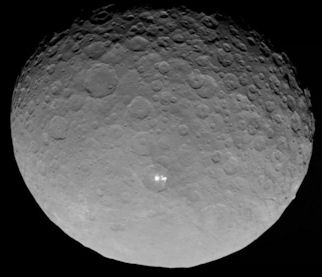
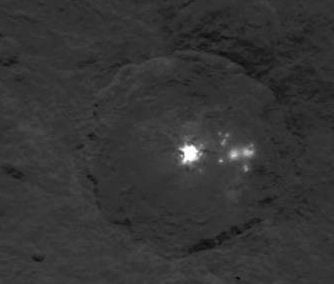
Image credits; NASA/JPL-Caltech/UCLA/MPS/DLR/IDA.
The counter-argument that this theory has encountered in the past is that there needs to be an internal source of heat and pressure to drive these volcanic processes, which on the face of it seems unlikely on an isolated planet of the size of Ceres. Water vapour was seen emerging from Ceres back in 2014, and it was thought that this effect might be due either to (a) cryovolcanoes, or to (b) the sublimation of ice to water vapour (in a similar fashion to that of comets) (7). Both possibilities have their merits and problems.
It's looking increasingly like Ceres may indeed be more geophysically active than previously thought possible for an isolated dwarf planet located in the asteroid belt. Back in September, news emerged of a 13,000' high ice mountain on the surface of Ceres, named Ahuna Mons, which is thought to be an ice volcano:
"Giant mountain Ahuna is a volcanic dome built from repeated eruptions of freezing salty water."
(8)It seems as though Ceres has an abundance of water ice (9), much of it lying close to its surface, and some of it wrapped up in this huge natural structure. One of the implications is that in the past liquid water once flowed over the Cerean surface. This seems eerily reminiscent of similar arguments about Mars, whose own atmosphere is too weak to sustain liquid water on the planet's surface. Yet, evidence suggests that water has indeed flowed across the red planet's surface. So, might Mars also have cryovolcanoes, covered in a heavy dusting of regolith? Might similar processes on Mars send plumes of water vapour into its atmosphere, thus falling back as freezing rain, becoming flash-flood channels upon the surface? This may well explain what's seen on Mars.
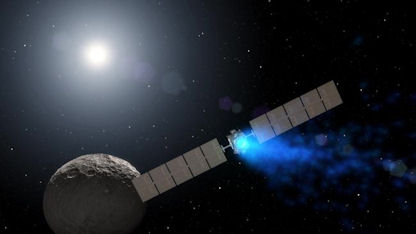
Image credit: NASA
Looking at the bigger picture, the solar system is providing us with evidence of more active geophysical processes than previously thought possible. Below the seemingly dull surfaces of various worlds, there is quite a lot going on. This flies in the face of theory, which previously considered these worlds to be essentially dead lumps of rock. Migration of planets seems a key factor, helping to explain why planets located within the snowline have so much water ice buried beneath the surface (which should have been driven off early in the lifetime of the solar system).
This opens up the possibility that the Earth, too, may have migrated from a different location further away from the Sun. Remember - the Earth also has a rather extensive water resource given its current relative proximity to the Sun. Water is also evident on the Moon. Now available abundantly on Ceres. Probably, then, under the surface of most asteroids?
Isn't it ironic that comets aren't 'dirty snowballs' as had been predicted for decades, but rocky bodies with internal volatiles? At the same time, asteroids may not be dead rocks after all, but complex, water ice-infused structures which include the remarkable 'ice palace' Ceres. It's all back to front, isn't it? The entire fabric of the solar system is testing the old and tired theory of steady-state ennui. Radical hypotheses are required to explain this about-turn.
Written by Andy Lloyd, 17th December 2016
References:
1
) Andy Lloyd "More Anomalies on Ceres" 27 June 2015andylloyd.org/darkstarblog27.htm
2) Andy Lloyd "The Mysterious Origin of Ceres" 2 January 2016
andylloyd.org/darkstarblog34.htm
3) Deborah Byrd "Ceres bright spots get names" 16 December 2016
4) Tracy Watson "NASA uncovers possibility of ice volcanoes on dwarf planet Ceres" 15 December 2016
5) AP Writers "Water ice has been found inside Ceres’ dark craters" 16 December 2016
6) Nico Schmedemann et al. "Timing of optical maturation of recently exposed material on Ceres", Geophysical Research Letters, 43(23): pp11,987-11,993, 16 December 2016
onlinelibrary.wiley.com abstract
7) Tanya Lewis "Water Found on Dwarf Planet Ceres, May Erupt from Ice Volcanoes" 22 January 2014
8) ASU Press Release "Ceres: The tiny world where volcanoes erupt ice" 1 September 2016
9) T. Prettyman et al. "Extensive water ice within Ceres’ aqueously altered regolith: Evidence from nuclear spectroscopy" Science, 355(6320): pp. 55-59, 15 December 2016
Our Readiness for Asteroid Impacts
The possible existence of Nibiru continues to be a talking point on the
Internet. My friend Jesse sent me an article from Israel
highlighting the very real threat from Near-Earth Object (NEO)/comet
bombardment and our lack of readiness for it.
The article
discusses the threat posed by a Planet X body, correlations with ancient
descriptions of Nibiru, and warnings set into Biblical text: "Fear of an apocalyptic
meteor strike is not new and even has sources in Judaism. Despite NASA
denying its existence, theories surrounding Nibiru, a large planetary
body many believe will strike the planet with catastrophic results,
persist. Just a few months ago, Rabbi Alon Anava, a prominent educator,
spoke about Planet X, also known as Nibiru, as one of the ways in which
God could send divine retribution. Rabbi Anava suggested that Nibiru was
the cause of the flood in the time of Noah, warning the same method
could be used again in the future." (1) NASA conducted a joint exercise with FEMA back in
October, looking at the consequences of a massive meteorite strike, and
our readiness for it. The simulation was part of a series of
exercises aimed at building collaborative ties between the two agencies
(2). The exercise presumed that deflection was not possible in the
timeframe envisaged, and concentrated instead upon communication between
emergency agencies, and how the probable impact zone could be safely
evacuated with the least collateral harm. This collaborative
exercise seems to be part of a wider effort. In January 2016, NASA
created the "Planetary Defense Coordination
Office" (PDCO) to monitor asteroid
observations and work with other space agencies to mitigate the
threat posed by incoming NEOs (3). NASA are going to start
experimenting with some cosmic billiards - sending two asteroid impactor
probes towards their designated targets to see what effect they can
have: "A joint European Space
Agency and Nasa mission will test such technology in the next few years,
under the name Asteroid Impact and Deflection Assessment (Aida). The
mission consists of two spacecraft, one called the Asteroid Impact
Mission (Aim), which will launch in late 2020, and the second, the
Double Asteroid Redirection Test (Dart), in 2021. "In 2022 they'll arrive at a
double asteroid called 65803 Didymos, which is accompanied by a
companion called Didymoon. Didymos measures some 780 metres across,
while Didymoon is about 170 metres. The smaller of the two orbits the
larger one every 11.9 hours, and they are close, only 1,100 metres
apart. The Aim craft will rendezvous with the asteroid and study its
composition. Once Dart arrives it will crash into Didymoon, and Aim will
see what the effect on the smaller rock's orbit is. The idea is to find
out exactly how much one can move an asteroid without running the risk
of sending it on a dangerous trajectory, a kind of baby step to actually
redirecting it." (3) The problem with such missions -beyond how effective
they may actually be in altering the trajectory of the asteroid itself -
is the turn-around time for such a mission. Is there enough time
between the realisation that there's an in-coming object posing a threat
to a localised zone on Earth (or worse) to get a mission off the ground
(literally) to deflect it? Perhaps that's why NASA and FEMA are
also simulating the need to evacuate a projected impact zone.
Written by Andy Lloyd, 17th December 2016
References:
1) Adam Eliyahu Berkowitz "NASA Trains for Nibiru-like Asteroid Apocalypse" 1 December 2016 with thanks to Jesse
breakingisraelnews.com article
2) D. Agle "NASA, FEMA Hold Asteroid Emergency Planning Exercise" 4 November 2016
3) Jesse Emspak "What would we actually do to Stop a 'Doomsday' Asteroid?" 11 May 2016
Proxima Centauri's Wide Orbit around the Alpha Twins
The European Southern Observatory (ESO) has confirmed that Proxima Centauri does indeed orbit the Alpha Centauri binary star system, rather than existing as an independent star in its own right (1). New, highly accurate measurements of Proxima Centauri's radial velocity compared with the two neighbouring stars indicate that it is slowly moving around Alpha Centauri A and B (2). The nature of this triple star system has big implications for other possible wide orbit objects - like a possible Nemesis-type object around our own Sun, for instance.
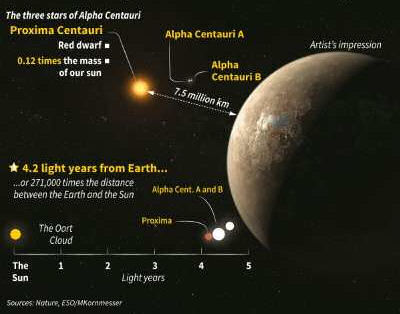
It also allows astronomers to date Proxima Centauri more accurately, as well as its
Earth-like exoplanet Proxima b:
"Taking account of these new
measurements, calculations of the orbits of the three
stars indicate that the relative velocity between
Proxima Centauri and the Alpha Centauri pair is well
below the threshold above which the three stars would
not be bound together by gravity. This result has
significant implications for our understanding of the
Alpha Centauri system and the formation of planets
there. It strongly suggests that Proxima Centauri and
the Alpha Centauri pair are the same age (about 6
billion years), and that in turn provides a good
estimate of the age of the orbiting planet, Proxima b."
(1)
I suspect that it is
quite normal for stars to have dark, massive objects
orbiting around them at great distances. Proxima
Centauri offers us a great precedent for this, but was
only visible to us because it is actually a blazing red
dwarf star. The system is about 6 billion years
old, quite a bit older than our Sun. Any objects
smaller than red dwarfs at this age would be essentially
dark - like brown dwarfs, or massive gas giant sub-brown
dwarfs. They would not be seen in the same way
that Proxima Centauri has been observed. Yet, such
dark objects could also be out there, orbiting parent
star systems at great distances. I think this
scenario is the norm; rather than an isolated, extreme
possibility.
Written by Andy Lloyd, 24th December 2016
References:
1) ESO "Orbit of Proxima Centauri Determined After 100 Years: Strongest evidence yet that Proxima Centauri orbits Alpha Centauri pair" 22 December 2016
2) P. Kervella, F. Thévenin & C. Lovis "Proxima’s orbit around α Centauri" Astronomy & Astrophysics, 598: L7, February 2017
The Doors of Durin
The following email exchange over took place over the Christmas period, in response to a previous article of mine about symbolism used by Tolkein in 'The Lord of the Rings', Freemasonry, and Dark Star symbolism: darkstar1.co.uk/ring.html

RE: central 'star' on The Doors Of Durin
Know that, esoterically speaking, a prominent star placed between two pillars/trees/etc on a door/opening symbolizes the planet Venus or the 'Morning/Evening Star'... which, as the Morning Star (the herald of the Sun before dawn), is historically known as Light-Bringer or Lucifer.
Pillars are male, openings/doors are female, and of course Venus is a female Goddess + the letter V itself is representative of the 'female delta' or the area between the legs and Vagina. Male pillars on either side of a female opening can be represented numerically as '101'; this is the point of entry of a physical or theoretical structure, understood esoterically as an initiation into knowledge or a school of thought. This is why introductory university courses, of various disciplines, are coded 101. To enter into the female opening and emerge again into the light is seen as a rebirth - the initiate emerges with new knowledge, transformed, and so sees the world with a new set of eyes, like being reborn :)
Arwen, who of course marries the King/Aragorn and so becomes Queen, is also associated with this 'star' or Goddess by way of one of her Elven names.
G.G. (27/12/16)
~~*~~
Dear G,
Thanks for your comment, which is much appreciated. What you say makes perfect sense, on a symbolic and esoteric level. I had not thought about 101 before, which is part of the American numbering system in university courses of course. Very interesting. These kinds of pillar markers are used in ancient monuments, and given the common nature of the appearance of Venus it seems unlikely that they would be set up for 'her'. Maybe there is some archaeo-astronomical reason to do with conjunctions etc, but there is also the possibility that this visual mechanism served a more occult reason, going back to ancient days. Who is to say really?
Andy (29/12/16)
~~*~~
Dear Andy,
The more occult symbolism is what I'm highlighting; I'm drawing attention to concepts of illumination.
The configuration of a pillar on either side of a door (the pillars being trees in the case of Durin's Doors - both the trees standing on either side of the doors + the trees on the design of the doors), this is representational of the bi-cycles governing our experience here, duality basically (note that '11', two pillars or 'Two Towers', is a symbol of duality). Like Boaz and Jachin of Solomon's Temple, Boaz / the left pillar or pillar of the Sun, Jachin / the right pillar or pillar of the Moon, the opposing forces of the daily 'bi-cycle' (like the popular brand of playing cards), of Day and Night, the opposing forces of the yearly bi-cycle, of Summer and Winter... light and dark, life and death, etc.
A great illustration of Venus (as light bringer / Lucifer) placed between the pillar of the Sun and the pillar of the Moon, and like on Durin's Doors being placed over or aligned with the crack of the doors / the female opening, is the doors of the grand temple of Freemasons' Hall in London. If you go to the Wikipedia page for Freemasons' Hall in London and scroll down, they have a high resolution image of the doors. (https://en.wikipedia.org/wiki/Freemasons'_Hall,_London) You will clearly see a sphere above the left and right pillars, for the Sun and Moon, and a shining sphere (with rays emanating from it) placed in the middle above the opening of the doors :)
G.G. (29/12/16)
~~*~~
Dear G,
I can see the wisdom in what you're describing. Our perspectives are slightly different, in that I believe that much of this symbolism arises from very ancient star religions (Egyptian/Mesopotamian) and that there is an archaeo-astronomical element to these symbolic constructions. In other words, the two pillars may originally have been horizon markers to denote a position of a star or planet in the sky, or during heliacal rising. Esoteric symbolism built up from the deities associated with these stars/planets then takes on importance within the later traditions which build upon the old star religions. Alchemy may have been a vehicle transposing one to the other, for instance, as perhaps may Freemasonry (although the idea that Freemasonry was directly derived from ancient times is contentious).
To derive such symbolic meaning for Durin's Doors, must we not assume that Tolkein was a Freemason? He was evidently using this kind of symbolism, but his own tradition was R.C. That's another issue. He may well have been exposed to this kind of symbolism and adapted it, either consciously or unconsciously. I don't know. I'd be interested to find out, of course, but I'm not sure there's a clear answer available about that.
Andy (30/12/16)
On Contemporary UFO Evidence
An occasional correspondent on mine, who likes to remain anonymous, asked me to to send him a movie with a real UFO in it. By this, I imagined he meant the best available contemporary UFO footage; as proof of alien visitation.
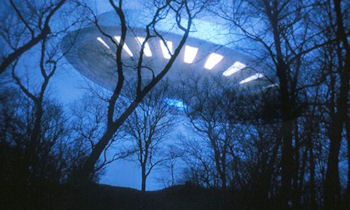
Here's my reply:
In answer to your question, I'm not sure that kind of quality UFO evidence exists. I've noticed that that the better the video technology available to ordinary people (through mobile phones, tablets etc), the less apparent the UFOs in the mass or social media. This suggests to me that there aren't UFOs in our skies, at least as a readily recordable phenomenon.
So, does than mean that all of those grainy and poor-quality photos and videos from the 50's, 60's, 70's, 80's of flying saucers and mysterious lights were hoaxes/misidentified, and so on? It could be. But what then of the many excellent 'unknown cases' scientifically examined by Project Blue Book, Grudge etc, the solutions to which remain mysterious?
Alternatively, it might suggest that the UFO phenomenon itself, if it has a reality, was of that time, and is no longer going on. If so, then I'd offer these two possibilities: (1) The UFO visitations of the 40's and 50's in particular were a response to our fledgling Atomic Age, which surely was a big step forward in our industrial prowess, and potentially an important step for us in terms of potential future space travel. Since then, the technology has plateaued and, thus, so has 'their' interest in us; (2) Our superpower nations have created covert space/atmospheric defences which keep the blighters out. We're pretty hostile towards incoming incursions into our airspace, and 'they've' got the message and stay away.
Andy (30/12/16)

You can keep informed of updates by following me on Twitter:
![]()
Or like my Facebook Page: https://www.facebook.com/darkstarandylloyd